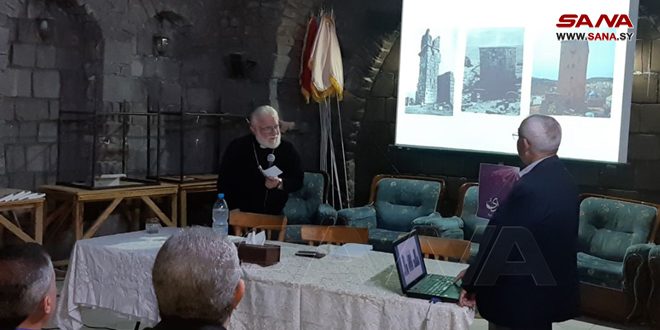Mada Cultural Team, in its second virtual trip in Syria, thrilled its audience with a visual presentation and a detailed explanation about “Sergila, the Pearl of the Forgotten Cities”. The event was hosted by the Syriac Catholic Archdiocese Hall in Old Homs.
The presentation was started by Father Dr. Michael Noaman of the Syriac Catholic Archdiocese with an explanation about the history of archaeological discoveries of forgotten cities in the mid-nineteenth century, and the characteristics of these cities and villages and their construction according to a single architectural style called “Syrian architecture”, to distinguish it from the classical Greek and Roman architecture.
Father Moaman pointed out that the most important characteristic of the construction of forgotten cities and villages is stones, the absence of wood and dependence on rain water, the construction of tanks to preserve them and the use of mosaics in the floors.
The Sarjila site is one of the most beautiful archaeological sites and one of the forgotten cities scattered in the area called the limestone block, and its name is Syriac in origin and means the light of God. The population began to settle there since the first centuries AD, when it reached the peak of its development and prosperity with the spread of Christianity between the fourth and sixth centuries AD, and witnessed a great urban movement that pervaded all regions and villages.
Sarjila’s antiquities, research and study of historical data provided a true picture of the situation of the countryside in northern Syria in the Roman and Byzantine periods with a close connection between all the cities and villages that formed an integrated unit of economic, social and religious importance. The types of buildings in Serjila, the most important of which are simple houses, villas, churches, mosques, bathrooms, public halls, olive presses, tanks, cemeteries and graves.
The bathrooms’ structure differed from that of the residential houses, as it consisted of a rectangle divided into two parts that include the parts of the bathroom which are linked by corridors and next to them there is a huge stone water tank.
The sizes and shapes of the residential houses vary, most of them consist of two floors, the ground floor is dedicated for living and storing materials, and the upper one is dedicated for housing, with corridors mounted on columns.
NR

